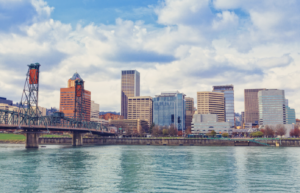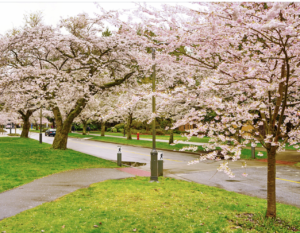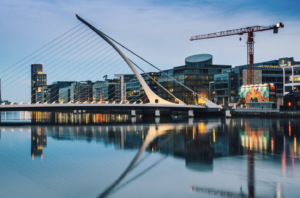Anúncios
Puerto Nariño is a sustainable living experiment with clean streets and no motor cars, similar to Copenhagen.
Leticia’s boat dock was full with market vendors, tuk-tuks, and water taxis. I purchased a ticket from a little kiosk on the Malecón seafront and traversed stilt-built wooden buildings to a series of floating platforms near the Amazon River. Steps to the water were lacking. A busy attendant handed out life jackets as I climbed down a treacherous slope with my ticket.
“Puerto Nariño?” I wanted to make sure I wasn’t on a boat to Brazil or Peru. “Sí,” he nodded, leading me to a covered motor launch. Thanks to a plastic seat at the bows, I had my first unimpeded glimpse of the world’s largest river.
Anúncios
Leticia and Puerto Nariño, Colombia, are distinct jungle towns situated 75km apart on the Amazon River. The former is a bustling border town with motorcycles and sellers. The latter is a peaceful sustainable living experiment with no cars and clean streets like Copenhagen’s. Puerto Nariño is a great example of a municipality on the right road, with Indigenous-led efforts, in a world of bleak climate projections.
Puerto Nariño is only accessible by boat from Leticia, a two-hour ride over the Amazon bordering Peru and Colombia. As I pulled into the community’s tiny boat dock at the Amazon and Loretoyaco rivers, I realized I’d landed at one of the jungle’s oddest outposts.
Anúncios
Puerto Nariño, known as “the natural cradle of Colombia,” is a good example of a community living in peace with nature. First town in the country to be declared a “sustainable tourist destination” by the Ministry of Commerce, Industry, and Tourism in 2012. Due to its proximity to the threatened rainforest that dominates climate change talks, a rising number of interested tourists want to see the planet’s “lungs” firsthand.
Recent Colombian Amazon news is mixed. Deforestation dropped 70% in 2023, but a severe drought harmed animals and caused unreliable harvests.
However, my first views of Puerto Nariño were positive. From the riverbank, neat terracotta walkways lined with shapely trees and bushes formed a grid, and attractive wooden houses decorated with lavish murals and eye-catching handicrafts showed a strong Indigenous presence: 80% of the settlement’s 6,000 residents are Ticuna, Cocama, and Yagua.
Unlike other crowded Colombian towns, vehicles and motorcycles are forbidden. Without roads, the town has just two registered vehicles: a tractor for trash collection and an ambulance for emergencies. Birdsong and shiny silver trash bins at practically every street corner created a peaceful, orderly atmosphere.
An exploratory walkabout introduced me to the neighborhood after paying a COP$15,000 (£3) admission levy for municipal upkeep. Not a typical Amazonian community with muddy pathways and overgrown vegetation. There were well-kept grass-fronted shops offering colorful items and surrealistic sculptures of turtles, pink dolphins, and parrots. A lively game of five-a-side football was being played beneath a huge metal canopy near the river, while community members with wheelbarrows and brooms were cleaning the paths.
The population of Puerto Nariño, founded in 1961, was mostly Indigenous people who had lived in the area for generations in family malocas (longhouses). It quickly attracted daring travelers.
“Starting in the 1980s and ’90s, the town began to attract small groups of tourists, who stayed in wooden hotels with basic services,” said Luz Jenny Torres, the municipality’s sustainable tourism head. “In the early 2000s, family groups and university students began visiting more often. Then-mayor Edilberto Suárez Pinto implemented a sustainability strategy in 2004, beautifying the metropolitan area, strengthening Indigenous tourism, and managing tourist infrastructure.”
Torres recommended to the mayor in 2007 that the municipality trial sustainable tourism nationwide. Following a strategy, Puerto Nariño became a model for green, grassroots tourism in a nation reviving from violence.
The present structure “has five environmental programs that are constantly monitored,” Torres said. “Management of water, energy, solid waste and pollution; along with the protection and conservation of flora and fauna.” Residents and visitors may shower with recycled rainwater, walk litter-free streets, and see monkeys and eagles up close.
This environmental stewardship is old. Since pre-Columbian times, Indigenous people have practiced sustainable agriculture by knowing their environment. Agriculture is still organized around chagras, tiny areas of land stripped of greenery and planted with crops during the dry season before being rotated to restore soil fertility.
Local families cultivate enough food on their chagras for themselves and sell the rest at a daily seaside market. I saw heaps of cassava, chilies, onions, squash, chicory, bananas, papayas, and mangos on the booths.
Dinner in town will be this. All hotels, including Puerto Nariño’s “poshest” Waira Selva, purchase products mostly from the market.
Most meals’ protein, amazon fish, was on display. The neighboring rivers include 68 species, including catfish, piranhas, and pirarucu, the world’s biggest freshwater fish.
Local fishermen monitor wildlife with Natütama, a 2005 nonprofit that runs an Indigenous-guided river life information center in town. In 2023, Natütama fishermen saw 1,044 pink dolphins and 134 critically endangered manatees, with more extensive surveys anticipated for 2024. Numbers matter beyond conservation. Dolphin viewing is a major tourist attraction in the area. Indigenous guides may lead wildlife tours in peque-peques to see pink dolphins, sloths, and turtles at Lake Tarapoto, a 2018 Ramsar wetlands site.
Natütama workers teach youngsters Amazonian ecology and host environmental seminars at universities and Indigenous villages in addition to monitoring endangered species. “Over the years, we have strengthened environmental and cultural education in schools, focusing particularly on grandparents,” said foundation education coordinator Marelvi Laureano of developing intergenerational understanding. “They are the people that provide the cultural knowledge that helps generate respect and care towards the community.”
Environment and education are centred at the interpretative center. “It recreates the year’s two different seasons,” Laureano said of exhibitions on rainy and dry seasons. “Inside, you’ll learn about the local lakes and jungle, how to identify the plants, fish and aquatic animals, and how they are divided on a natural scale.”
We teach dances, provide Indigenous cuisine, tell animal stories, and protect the environment.
Travelers may experience Indigenous life elsewhere in the municipality. “Visitors can learn dances, taste typical Indigenous food, hear myths and legends about different animals, and see the work we do caring for the environment,” he added.
A notable feature of Puerto Nariño’s conservation is its local leadership. “Indigenous people represented by the organisation ATICOYA, have always participated in everything related to the process,” he said.
After seeing Natütama, I took a guided boat ride to Lake Tarapoto and swam (despite the piranhas). To conclude the day, climb Puerto Nariño’s wooden tower for a stunning view of the river and vegetation.
Several shops serve handmade tropical-flavored ice cream at the tower’s base. I tried camu camu, a vitamin C-rich purplish cherry-like fruit, and walked around town admiring its eco-initiatives: recycled plastic bottle plant pots, meticulously maintained gardens, and a water filtration plant where most of the town refills its bottles.
I loved a tiny restaurant with a patio beside the five-a-side football court where I ate grilled fish amid the players’ shouts before retiring to my humble cabin.
At night, Puerto Nariño’s traffic-free tranquility was calming. The town has achieved an odd combination of jungle mellowness and Scandinavian-style order amid the world’s biggest rainforest thanks to communal power. It may not solve Amazon’s complex environmental concerns, but it’s a start.






